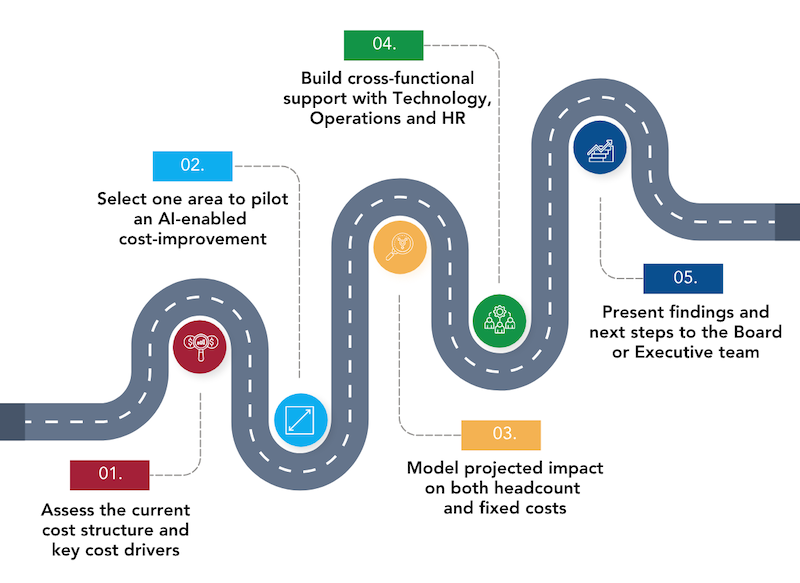In this article, the author explores how FP&A professionals can champion Change Management to break down...

Why Traditional Cost-Cutting No Longer Works
Cost pressures are rising across industries, but traditional cost-cutting often causes long-term damage. FP&A professionals, with their enterprise-wide lens, are uniquely positioned to lead a smarter, AI-enabled approach to cost optimisation.
Next time you visit your local supermarket, walk into a hotel, or even an airline, have a look around to see what potential "cost optimisation" has taken place. My personal observations here include standardised coloured shelves and the use of supplier containers at my local supermarket, the absence of bed linen replacements during my last stay at a regional hotel chain (unless specifically requested), and the complete removal of entertainment systems on short-haul flights on a full-service carrier.
Cost Optimisation (or plain hard cost-cutting), rooted in industrial-era efficiency drives, stems from the need to narrow one's cost structure, especially during economic/business downturns. In recent years, every company, regardless of size, has seen some level of cost optimisation deployed across its business model.
Here, Financial Controllers/FP&A professionals are called to manage such introspective exercises. As one of the few individuals who share a holistic view of a business's cost base, the pressure is on to ensure that cost-cutting does not gut the business and that operations can continue unscathed on a lower cost base.
Benjamin Franklin once said, "Beware of little expenses. A small leak will sink a big ship". Personally, I have been in businesses where we zoomed in on ridiculously tiny items, such as downgrading the brand of beer for the company's Friday post-work Beer parties or switching to cheaper (worse-tasting) coffee beans at the various office locations. These intrinsic changes, which may at first sound practical given they are non-business critical, do not fundamentally alter the business cost base nor the long-term viability.
FP&A's real opportunity lies in influencing deeper, structural cost drivers, supported by AI insight rather than short-term fixes.
How Traditional Approaches Fall Short
Historically, the direct way is a top-down approach where the Board/Management sets a target of a cost base that the various teams must then achieve. Whilst this methodology gathers quick short-term savings, the long-term consequences can be dire, with innovation being curbed, the risk of demotivating personnel, and curtailing a business's ability to grow.
Meanwhile, massive layoffs have been announced in larger companies such as Meta, Amazon, and Microsoft in recent years, with plans for jobs to be replaced by AI agents. For example, the use of robots at Amazon warehouses simultaneously cuts down office spaces, permanently narrowing the business cost base. Mid-sized to smaller companies that may find it challenging to replicate such drastic measures can utilise modern AI solutions to study their cost structure and gain insights into making informed cost-cutting decisions.
This is where FP&A can play a strategic role — not just executing cuts but shaping smarter, data-backed cost structures.
FP&A + AI = A Strategic Cost Engine
Modern FP&A and Controlling teams are increasingly stepping into a strategic role, acting as internal consultants who challenge, support, and partner with the business. When augmented by AI, they become even more powerful.
AI enables us to move beyond descriptive analytics (what happened) to predictive (what will happen) and even prescriptive insights (what should we do). This transformation empowers finance teams to provide proactive, real-time guidance that drives smarter decision-making.
To maximise this potential, FP&A teams need to embed AI into core processes, from driver-based planning to real-time forecasting and manual routine automation.
Five Functional Use Cases: AI Applications by Department
Regardless of size/maturity/scale, most organisations lack the technical maturity to scale AI initiatives. That said, organisations can easily democratise this process.
- Align spending with measurable results
- Streamline processes to their core essentials
- Use fast-paced digital innovation to redesign value chains
The use of AI needs to be blended with leadership stemming from the C-level and strong support from the Board. While AI is a fantastic tool to quickly identify, analyse, and provide solutions to cost optimisation, the overall exercise requires people from various areas of expertise to come together to draw a plan. The top finance, operations, technology, and supply chain executives in the organisation should coordinate a high-level working committee to undertake a deep study of the organisation's processes and a complete rethink of the way the organisation runs. Here, quick wins can be achieved by automating traditional processes.
To support this, the table below illustrates practical AI use cases across departments and where they may impact the cost structure. FP&A can play a leading role in identifying, piloting, and scaling these opportunities.

Figure 1. AI-Driven Cost Optimisation Use Cases by Department
The suggested measures above can potentially impact the organisations' long-term cost structure, leading to a more efficiently run business. Interestingly, there will be an enormous chance of saving personnel costs in most cases, reflecting the automation that will enable this. That said, this does not take into consideration the possible retraining of staff or the cost of implementation, which can all collectively be regarded as one-time expenses/investments into the longevity of the business.
FP&A's role here is to partner with each function to quantify cost benefits, build ROI models, and communicate trade-offs to senior leadership.
Build an Automation Culture That Works
Depending on the business size/goals/model, numerous other ways exist to effectively deploy AI into business processes. That said, organisations looking to continuously optimise costs need to encourage a strong automation culture. For example, organisations can create goals for departments to automate 10–20% of their processes, with financial rewards awarded at the end.
It is vital to have the buy-in of employees, especially middle management, who will execute operationally the enforcement of such a culture. Their expectations need to be firmly managed as the loss of their jobs may spark some hesitation. This is where the Board/C-level needs to step up to reiterate the importance of employees, and that automation helps in the long-term sustainability of the business, leading to steady employment for everyone. This can only happen with a clear communication strategy that seeks to address legitimate concerns.
This culture shift must be underpinned by clear metrics, leadership messaging, and aligned incentives, and FP&A can help define these from the centre.
How FP&A Can Lead the Transformation
The FP&A team is at the centre of all of this, driving automation strategies and acting as a reliable business partner through this business transformation stage. FP&A will be called to build models to demonstrate potential savings across the different departments, challenging the practicality of assumptions and key drivers. For this to happen, FP&A's integral role needs to be endorsed by the Board/C-level, empowering it to drive its measures across the organisation.
FP&A can also propose phased pilots, quantify quick wins, and track performance improvement, showcasing the function's strategic value.
Conclusion: Five Steps FP&A Can Take Now
In summary, the most optimal way forward to ensure a narrow cost base within organisations is empowering departments to utilise AI in their daily processes. The backdrop of the challenging global economic and political conditions will organically force businesses to either optimise or get out-competed. Regardless of size, there are many practical ways and quick deployment methods for AI across organisations. That said, the Board/C-level needs to promote an automation-first culture to truly benefit from AI's benefits while ensuring their business's longevity.
For FP&A leaders, the next steps are clear:
- Assess the current cost structure and key cost drivers
- Select one area to pilot an AI-enabled cost-improvement
- Model projected impact on both headcount and fixed costs
- Build cross-functional support with Technology, Operations, and HR
- Present findings and next steps to the Board or Executive team
Smarter cost decisions start with smarter analysis, and FP&A is best placed to deliver it.

Figure 2. Five Steps for Smarter, AI-Driven Cost Optimisation
"Disclaimer: The views and opinions expressed in this article are solely my own and do not represent the views of my current or former employers."
Subscribe to
FP&A Trends Digest

We will regularly update you on the latest trends and developments in FP&A. Take the opportunity to have articles written by finance thought leaders delivered directly to your inbox; watch compelling webinars; connect with like-minded professionals; and become a part of our global community.







